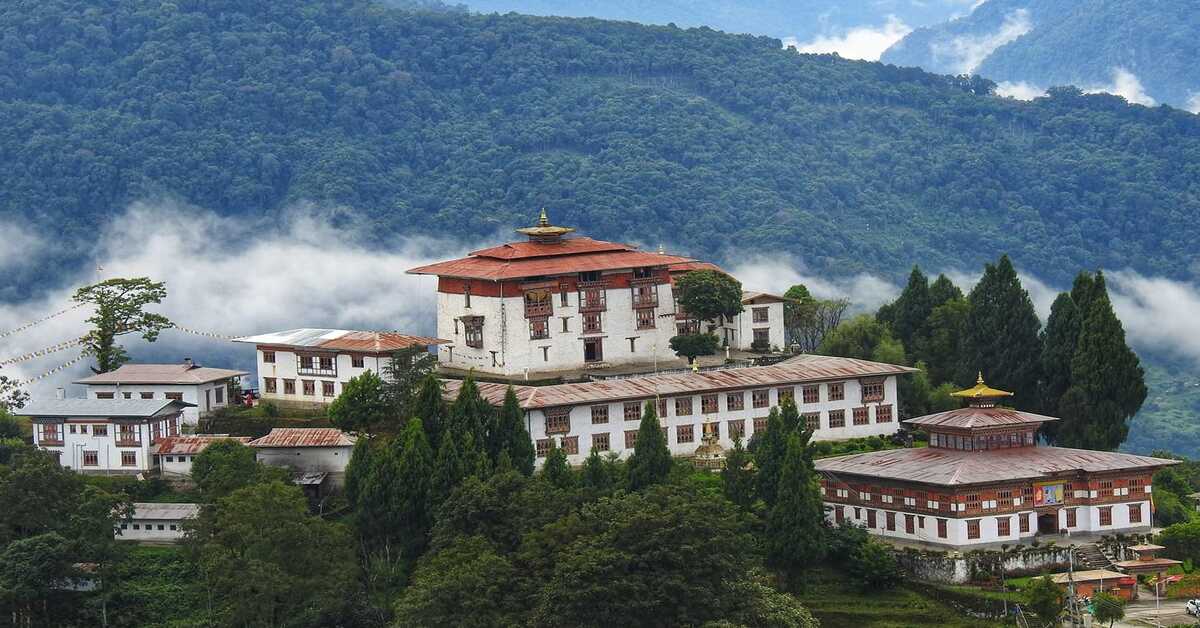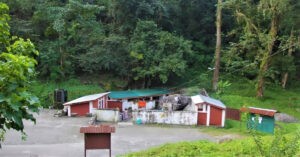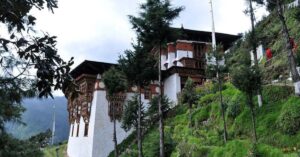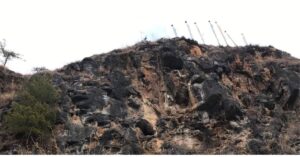Zhemgang Dzong, also known as Druk Dechen Yangtse Dzong, is one of the 16 dzongs built by the Zhabdrung Ngawang Namgyal in Bhutan to mark the unification of Khengrig Namsum in 1655. It was built over the hermitage founded by Lama Zhang Dorji Dragpa in 1163 AD.
The Dzong stands atop a ridge rising sharply from Mangde Chhu. Located at an elevation of about 2000 meters in Zhemgang Dzongkhag, it faces the village of Trong and Zhemgang town.
In the 1980s, the district administration headquarters were moved to a separate two-story building from the original dzong. Zhemgang Dzong now functions as both an administrative center and a residence for the monastic body.
How to Reach Zhemgang Dzong
Zhemgang Dzong is beautifully situated atop the peak of a triangularly shaped ridge in Zhemgang. The most common way to reach Zhemgang Dzong is by road from Thimphu, which is a roughly 6-hour drive; alternatively, you can travel from Gelephu town, which is accessible via the Gelephu-Trongsa highway.
Also Read: Wangdue Phodrang Dzong, the Fortress of Glorious Unification
History of Zhemgang Dzong
According to Zhemgang Dzong’s history, Zhemgang Dzong was founded by Lama Zhang Dorje Drakpa in the 12th century. He established a hermitage and lived there for many years. The founder gave the Lhakhang the name Zhangang, which means “immeasurable mound” based on his name. Thus, Zhemgang is a corrupted name derived from Zhangang.
Until the 17th century, Zhemgang was split into several kingdoms, with nine Dungs, two Khoches, and four Ponpos. However, in the 17th century, Zhabdrung Ngawang Namgyal started the unification of the central region after consolidating the eastern region. He appointed Trongsa Penlop Chogyal Minjur Tempa to intervene in the strife among the local chieftains and take control of the kheng regions. The Trongsa Penlop defeated the most powerful Nyakhar Dung’s force, while other local chieftains surrendered. Thereafter, the whole region of Kheng was unified under Khengrig Namsum. A single-storied Zhemgang Dzong was built to symbolize the unification of the three Kheng divisions on the site where Lam Zhang built a hermitage in 1655.
Zhemgang was established as a separate Dzongkhag in 1963. In the 1980s, it underwent renovations and was renamed Dechen Yangtse Dzong by His Majesty King Jigme Dorji Wangchuk. The Dzongkhag administration moved to a separate two-story building. Since then, the Dzong has continued to serve as an administrative and monastic center.
Also Read: History of Gasa Dzong, the Fortress that defended against Northern Invasions
Significance of Zhemgang Dzong
Zhemgang Dzong is of significant historical, political, and religious importance. During the 17th century, it played a crucial role in consolidating the Kheng region under Bhutan’s central government after political strife among local chieftains.
This one-storied dzong, constructed in 1655, symbolizes the unification of the three Kheng divisions—Upper, Middle, and Lower Kheng.
Also Read: Significance of Paro Rinpung Dzong, the Fortress on a Heap of Jewels
Description of Zhemgang Dzong Complex
Zhemgang Dechen Yangtse Dzong comprises three main structures: the Dzong, the residence of the district monk body, and a two-story administrative building. The Utse, once a Palace, is the oldest building in the Dzong and has a distinctive typology. The Dzong has a large courtyard accommodating more than one thousand people.
Zhemgang Dzong has six Lhakhangs: Goenkhang, Lamai Goenkhang, Naib Lhakhang, Guru Lhankhang, Mithrub Lhakhang, and Kuenrey Lhakhang. Goenkhang is considered the most sacred and is believed to have been built by Lam Zhang. It houses the oldest relic, a six-inch gold-plated statue of Lam Zhang that mysteriously survived two fires that destroyed the dzong. The Naib Lhakhang is dedicated to Dorji Rabten, whom Lam Zhang appointed as the deity of the dzong.
Also Read: Punakha Dzong, the Palace of Great Bliss on the Heaped Jewel
Zhemgang Tshechu Festival
The annual Zhemgang Tshechu festival was instituted in 1966, following the inception of the monastic body. However, it was first observed in 1975. The five-day festival is held from the 7th to the 11th of the second month of the Bhutanese calendar.
During the festival, various mask dances and regional folk songs are performed. The festival’s highlight is the unfurling of Guru Rinpoche’s Thongdrol.
Also Read: The Festival of Tashichho Dzong, a Fortress at the Site of Blue Stone Dzong
Best Time to Visit Zhemgang Dzong
The best times to visit Zhemgang Dzongkhag in Bhutan are in the spring (March to May) and autumn (September to November). Plan your trip during the annual festival to fully immerse yourself in the local culture, experience distinctive customs, take in lively celebrations, and see exciting performances that may not be easily accessible during regular times. You can visit the major pilgrimage sites of Zhemgang with the Bhutan Pilgrimage Package.
Conclusion
Zhemgang Dzong is the oldest and most significant religious structure in Zhemgang. It is on a ridge overlooking the Mangde Chhu River and symbolizes the region’s spiritual and historical significance. Lama Zhang Dorje Drakpa founded it in 1163 AD. Later, a one-story dzong was constructed in 1655 to unify the three Kheng divisions. Zhemgang was established as a separate Dzongkhag in 1963. Since then, the Dzong has continued to serve as an administrative and monastic center.
Other Sacred Sites to Explore in Zhemgang
Buli Tsho: A sacred lake in Zhemgang revered as the palace of the protector deity Tshomen Kuntu Zangmo. It’s a significant pilgrimage site where locals seek blessings and spiritual solace through rituals and prayers to accumulate merit and ward off misfortune.
Duenmang Tshachu: Known as Kheng Tshachu, it is a renowned hot spring believed to heal various ailments, including indigestion, joint pain, sinusitis, and skin diseases.
Trong Heritage Village: Traditional stone masonry houses on a hillock overlooking Zhemgang Dzong. It showcases Bhutanese architecture with earthquake-resistant techniques and cobbled pathways.
Wamling Gaden Tashicholing: A Buddhist monastery or institution, likely inspired by the Gaden tradition of Tibetan Buddhism, which emphasizes the teachings of Lama Je Tsong Khapa.
Frequently Asked Questions
Who built Zhemgang Dzong?
Zhemgang Dzong was originally founded as a hermitage by Lama Zhang Dorje Drakpa in the 12th century. Later, in 1655, a single-storied dzong was constructed on the site of Lama Zhang’s hermitage by the Trongsa Penlop Chogyal Minjur Tempa under the orders of Zhabdrung Ngawang Namgyal, symbolizing the unification of Khengrig Namsum.
Enjoyed reading this blog?




